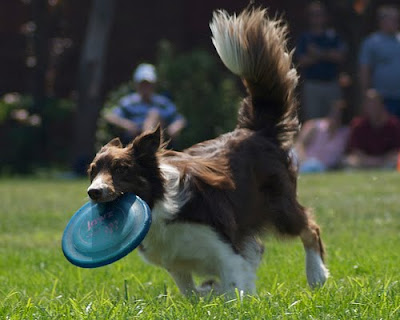Like everyone knows, I am planning a litter and some concerns with the future of the puppies that I am placing in this world, just keep crossing my mind.
Of course living in a country where people seem to consider so lightly the responsibility of marriage, having children and having animals, I keep worrying about my puppies future.
In the other day I was surfing the net, trying to find out which breeds are more commonly abandoned in Europe (Portugal), and I found this very interesting article that really shows some huge problems here and in USA (since I believe that we aren’t that different).
The Most Misunderstood Dogs in America
November 04, 2006, 12:0AM MT
By T V
A look at five breeds often left abandoned. Their worst offense? Their human owners never should have bought them.
For some dogs, their only crimes are unrealistic expectations. As a result, they're misunderstood, and some are downright hated. Some breeds have such a bad rap that they need a press agent. Others have such idealistic "Lassie" images that it's nearly impossible to live up to them.
The Humane Society of the United States estimates that 6 million to 8 million dogs and cats are relinquished to shelters annually, and about half of those are euthanized. We don't know which breeds are relinquished most often, but when I asked four dog experts which five breeds they think are most often abandoned, their picks were unanimous and mirrored my own hunches.
"My dream is that people would choose the right dog to match their lifestyles," says Ian Dunbar, founder of the Association of Pet Dog Trainers. "Then, once you have that dog, understand what you're dealing with," adds Ledy VanKavage, senior director at the ASPCA.
Unfortunately, that doesn't happen enough, and it leads to this list.
Rottweilers
This large dog with a head the size of a small dog can grow up to 27 inches and exceed 130 pounds. "They're big, strong, and can be headstrong," Bradley says. "They're NOT for everyone."
Rotties that don't have good training when they're young may have behavioral problems as adults. These dogs suffer from bad press. Some insurance companies increase their homeowner fees for Rottweilers (and often other large breeds, including pit bulls), and people sometimes feel they have no choice but to give up their dogs.
"Pit Bulls"
(oh, and any dog that resembles one, such as a Staffordshire bull terrier, American Staffordshire terrier, or bull terrier).
"They're easily the most vilified, even hated, dog," says Janis Bradley, author of Dogs Bite but Balloons and Slippers Are More Dangerous. VanKavage calls it a witch hunt - and she ought to know.
She has three pit bulls: "They're clowns; they make me laugh." VanKavage says there are instances when pit bulls run up to kids to say "hi", the parent panics, the authorities arrive, and they deem the dog dangerous for no good reason. "If that dog was a golden retriever, nothing would have happened", she says.
Bradley goes so far as to equate these situations to a canine version of racism.
Many shelter dogs have a pit bull-type look. Rescuing a pit has become trendy, and the experience can go smoothly. "But understand what you're getting into", Dunbar warns. "Some come with difficult-to-deal-with behavioral baggage."
Labradors and Lab Mixes
Labs? Misunderstood? Really? YES REALLY!
People expect Labs to be perfectly trained, like the service labs who team with the visually or physically impaired. "Here's the reality: They were bred to work under difficult conditions and have the drive to swim through ice to get that bird", says Patricia McConnell, author of For the Love of a Dog: Understanding Emotion in You and Your Best Friend.
That's not to say that with training and time they don't settle down, but they're not the instant soup people expect. "The expectations are so high, it's difficult to live up to", VanKavage says. "They're great dogs for a fairly active family, but not for elderly Aunt Tilda", Bradley adds.
"And because Labs are large, they can easily learn to drag Aunt Tilda down the street". Golden Retrievers can have the same problems.
Border Collies
"Exercise for Border Collies is measured in hours, not minutes", McConnell says. "They require a job and mental exercise to go with the physical exercise. An outlet for their intensity is important, or they can develop problems".
McConnell rescued a compulsive spinning and licking border collie. The previous owners were unable to meet the dog's needs, and they couldn't cope with what they had. McConnell named her Lassie. Today, Lassie is normal - normal for a border collie, that is. She has sheep to herd, and she gets plenty of exercise.
Terriers and Terrier mixes
Many are under 30 pounds, but don't let their size fool you. "It's a whole lot of dog in one package", Dunbar says. "They're dynamic, they're fast, they're tough, and they're actively telling you all about it".
Most aren't demure about barking. There's a reason they're sometimes called TERRORS instead of terriers. "Really, all they require is training", McConnell says. "It's true for all dogs. It's not the dog's fault if it has no training". Although their generally smaller size is suitable to apartment life, sometimes terriers' vocal nature doesn't endear them to neighbors.
Certainly, there's no reason for constant barking, but some people actually expect compelte silence - and that's just not the terrier way.
by Steve Dale
Source: http://www.usaweekend.com/06_issues/061224/061224animalsmart.html








